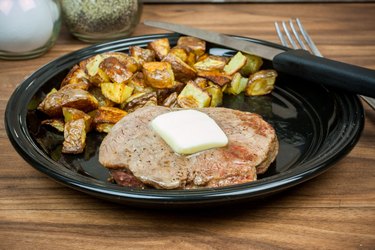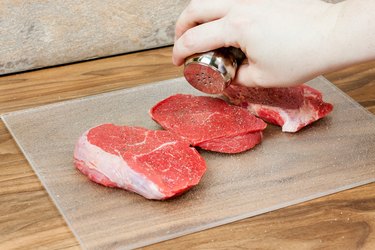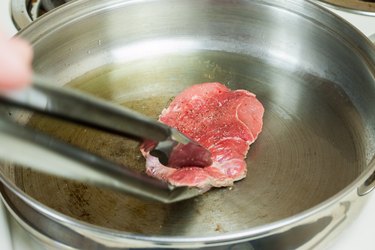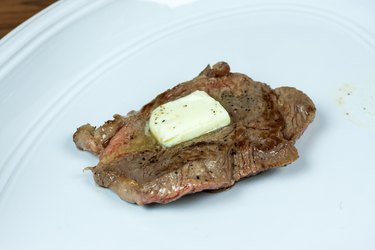
Pan-seared steak, meaning a steak cooked on the stove, is a quick way of getting a steak from your fridge to your dinner table with little fuss. A stove top steak can be marinated or cooked as is, with no more than a sprinkle of salt and pepper. The steak should be thick enough to develop a good sear on the outside without overcooking on the inside.
Cuts and Thickness
Video of the Day

Choose from rib eye, strip, tenderloin or T-bone steaks. Rib eye and T-bone steaks are fatty and rich tasting, while strip and tenderloin steaks are tender and less fatty. Choose steaks that are at least 1 1/2 inches thick, ideally 2 inches, as this will determine how well a steak can tolerate high heat and develop a crust without overcooking. If the thickness makes a steak too large for one person, serve one steak for two people rather than trying to panfry a thinner steak.
Video of the Day
Pan Choices and Seasoning

A thick, heavy pan that can be heated to smoking-hot temperatures works well for stove top steaks, but a cast iron pan is ideal. Marinate or season the steak with salt and other spices at least 40 minutes prior to cooking. If you have time, season your steaks several days in advance. Although you can add salt to a steak just before cooking -- the saltiness will be on the exterior rather than throughout the steak -- avoid doing this with spices and herbs. Spices and herbs added just before cooking will burn during cooking, and the flavors they impart will not have time to work their way through the meat.
Cooking and Doneness

Pour a small amount of vegetable oil in your pan and heat until the oil begins to smoke slightly. Do not use butter at this point as it will only burn. Pat dry your steak before placing it in the pan, even if it is marinated. Place your steak in the center of the pan and let it sit for 30 seconds. Flip your steak every 30 seconds, as this will ensure even cooking and a good crust on your steak without overcooking one side. Baste your steaks with the pan juices in between flips, spooning the oil onto the side of the steak that is not touching the pan. This cooks your steak from all sides. Test for doneness by pressing on the steak. Rare steaks have a lot of give, while medium-rare and medium steaks have slight resistance. Well-done steaks have little give when pushed. Use a quick-read thermometer to test for doneness.
Finishing, Resting and Serving

If you want to use butter for your steak, add it roughly one minute before the steak is done to avoid burning the butter. Or, place a pat of butter on your steak as you let it rest. Resting your steak after cooking is important, as it gives the juices time to redistribute through the meat. If you have a quick-read thermometer, your steak is done resting when it is 5 degrees Fahrenheit below the ideal maximum temperature. So, for a medium-rare steak, serve it when the internal temperature reads 125 F. If serving your steak sliced, cut it across the grain in slices no thicker than 3/4 inch.